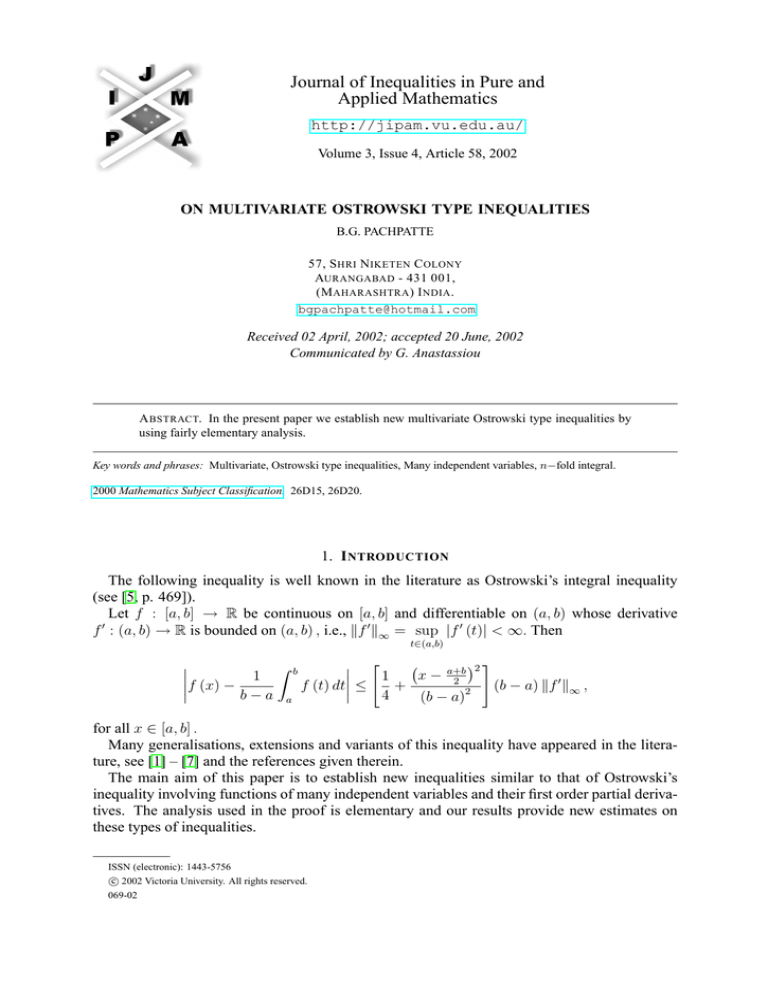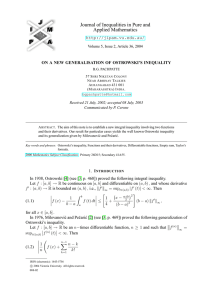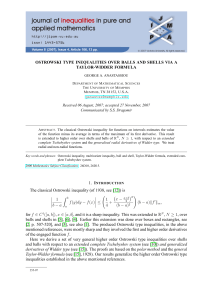
Journal of Inequalities in Pure and
Applied Mathematics
http://jipam.vu.edu.au/
Volume 3, Issue 4, Article 58, 2002
ON MULTIVARIATE OSTROWSKI TYPE INEQUALITIES
B.G. PACHPATTE
57, S HRI N IKETEN C OLONY
AURANGABAD - 431 001,
(M AHARASHTRA ) I NDIA .
bgpachpatte@hotmail.com
Received 02 April, 2002; accepted 20 June, 2002
Communicated by G. Anastassiou
A BSTRACT. In the present paper we establish new multivariate Ostrowski type inequalities by
using fairly elementary analysis.
Key words and phrases: Multivariate, Ostrowski type inequalities, Many independent variables, n−fold integral.
2000 Mathematics Subject Classification. 26D15, 26D20.
1. I NTRODUCTION
The following inequality is well known in the literature as Ostrowski’s integral inequality
(see [5, p. 469]).
Let f : [a, b] → R be continuous on [a, b] and differentiable on (a, b) whose derivative
0
f : (a, b) → R is bounded on (a, b) , i.e., kf 0 k∞ = sup |f 0 (t)| < ∞. Then
t∈(a,b)
#
"
Z b
a+b 2
x
−
1
1
2
f (x) −
f (t) dt ≤
+
(b − a) kf 0 k∞ ,
2
b−a a
4
(b − a)
for all x ∈ [a, b] .
Many generalisations, extensions and variants of this inequality have appeared in the literature, see [1] – [7] and the references given therein.
The main aim of this paper is to establish new inequalities similar to that of Ostrowski’s
inequality involving functions of many independent variables and their first order partial derivatives. The analysis used in the proof is elementary and our results provide new estimates on
these types of inequalities.
ISSN (electronic): 1443-5756
c 2002 Victoria University. All rights reserved.
069-02
2
B.G. PACHPATTE
2. S TATEMENT OF R ESULTS
In what follows, R denotes the set of real nummbers, Rn the n−dimensional Euclidean space.
Let D = {(x1 , . . . , xn ) : ai < xi < bi (i = 1, . . . , n)} and D̄ be the closure of D. For a function u (x) : Rn → R, we denote the first order partial derivatives by ∂u(x)
(i = 1, . . . , n) and
∂xi
R
R b1
R bn
u (x) dx the n−fold integral a1 · · · an u (x1 , . . . , xn ) dx1 . . . dxn .
D
Our main results are established in the following theorems.
Theorem 2.1. Let f, g : Rn → R be continuous functions on D̄ and differentiable on D whose
∂f
∂g
, ∂x
are bounded, i.e.,
derivatives ∂x
i
i
∂f (x) ∂f ∂xi < ∞,
∂xi = sup
x∈D
∞
∂g = sup ∂g (x) < ∞.
∂xi ∂xi x∈D
∞
Let the function w (x) be defined, nonnegative, integrable for every x ∈ D and
Then for every x ∈ D̄,
(2.1)
(2.2)
R
D
w (y) dy > 0.
Z
Z
1
f (x) g (x) − 1 g (x)
f
(y)
dy
−
f
(x)
g
(y)
dy
2M
2M
D
D
n ∂f ∂g 1 X
Ei (x) ,
|g (x)| + |f (x)| ≤
2M i=1
∂xi ∞
∂xi ∞
R
R
g
(x)
w
(y)
f
(y)
dy
+
f
(x)
w (y) g (y) dy D
D
f (x) g (x) −
R
2 D w (y) dy
i
h
R
Pn
∂f ∂g w (y) i=1 |g (x)| ∂xi + |f (x)| ∂xi |xi − yi | dy
D
∞
R ∞
≤
,
2 D w (y) dy
where M = mes D =
Qn
i=1
(bi − ai ) , dy = dy1 . . . dyn and Ei (x) =
R
D
|xi − yi | dy.
∂g
= 0 in Theorem 2.1, then the inequalities
Remark 2.2. If we take g (x) = 1 and hence ∂x
i
(2.1) and (2.2) reduces to the inequalities established by Milovanović in [3, Theorems 2 and 3]
which in turn are the further generalisations of the well known Ostrowski’s inequality.
Theorem 2.3. Let f, g,
(2.3)
∂f
, ∂g
∂xi ∂xi
be as in Theorem 2.1. Then for every x ∈ D̄,
Z
1
f (x) g (x) − f (x)
g (y) dy
M D
Z
Z
1
1
− g (x)
f (y) dy +
f (y) g (y) dy M D
M D
! n !#
Z " X
n X ∂g ∂f 1
≤
dy,
∂xi |xi − yi |
∂xi |xi − yi |
M D
∞
∞
i=1
i=1
J. Inequal. Pure and Appl. Math., 3(4) Art. 58, 2002
http://jipam.vu.edu.au/
M ULTIVARIATE O STROWSKI T YPE I NEQUALITIES
(2.4)
3
Z
f (x) g (x) − f (x) 1
g (y) dy
M D
Z
Z
Z
1
1
g (y) dy − g (x)
f (y) dy + 2
f (y) dy
M D
M
D
!D n !
n
X ∂f X ∂g 1
≤ 2
∂xi Ei (x)
∂xi Ei (x) ,
M
∞
i=1
i=1
∞
where M, dy and Ei (x) are as defined in Theorem 2.1.
Remark 2.4. We note that in [1] Anastassiou has used a slightly different technique to establish
multivariate Ostrowski type inequalities. However, the inequalities established in (2.3) and (2.4)
are different from those given in [1] and our proofs are extremely simple. For an n−dimensional
version of Ostrowski’s inequality for mappings of Hölder type, see [2].
3. P ROOF OF T HEOREM 2.1
Let x = (x1 , . . . , xn ) and y = (y1 , . . . , yn ) x ∈ D̄, y ∈ D . From the n−dimensional
version of the mean value theorem, we have (see [8, p. 174] or [4, p. 121])
(3.1)
(3.2)
f (x) − f (y) =
g (x) − g (y) =
n
X
∂f (c)
i=1
n
X
i=1
∂xi
(xi − yi ) ,
∂g (c)
(xi − yi ) ,
∂xi
where c = (y1 + α (x1 − y1 ) , . . . , yn + α (xn − yn )) (0 < α < 1) .
Multiplying both sides of (3.1) and (3.2) by g (x) and f (x) respectively and adding, we get
(3.3) 2f (x) g (x) − g (x) f (y) − f (x) g (y)
n
n
X
X
∂f (c)
∂g (c)
= g (x)
(xi − yi ) + f (x)
(xi − yi ) .
∂x
∂x
i
i
i=1
i=1
Integrating both sides of (3.3) with respect to y over D, using the fact that mes D > 0 and
rewriting, we have
Z
Z
1
1
(3.4) f (x) g (x) −
g (x)
f (y) dy −
f (x)
g (y) dy
2M
2M
D
D
"
#
Z X
Z X
n
n
1
∂f (c)
∂g (c)
=
g (x)
(xi − yi ) dy + f (x)
(xi − yi ) dy .
2M
D i=1 ∂xi
D i=1 ∂xi
From (3.4) and using the properties of modulus we have
Z
Z
1
f (x) g (x) − 1 g (x)
f (y) dy −
f (x)
g (y) dy 2M
2M
D
D
"
#
Z X
Z X
n
n ∂f (c) ∂g (c) 1
≤
|g (x)|
∂xi |xi − yi | dy + |f (x)|
∂xi |xi − yi | dy
2M
D i=1
D i=1
n ∂f ∂g 1 X
Ei (x) .
≤
|g (x)| + |f (x)| 2M i=1
∂xi ∞
∂xi ∞
The proof of the inequality (2.1) is complete.
J. Inequal. Pure and Appl. Math., 3(4) Art. 58, 2002
http://jipam.vu.edu.au/
4
B.G. PACHPATTE
Multiplying both sides of (3.3) by w (y) and integrating the resulting identity with respect to
y on D and following the proof of inequality (2.1), we get the desired inequality in (2.2).
4. P ROOF OF T HEOREM 2.3
From the hypotheses, as in the proof of Theorem 2.1, the identities (3.1) and (3.2) hold.
Multiplying the left and right sides of (3.1) and (3.2) we get
(4.1) f (x) g (x) − f (x) g (y) − g (x) f (y) + f (y) g (y)
" n
#" n
#
X ∂f (c)
X ∂g (c)
=
(xi − yi )
(xi − yi ) .
∂xi
∂xi
i=1
i=1
Integrating both sides of (4.1) with respect to y on D and rewriting, we have
(4.2) f (x) g (x) − f (x)
1
M
Z
g (y) dy
Z
Z
1
1
f (y) dy +
f (y) g (y) dy
− g (x)
M D
M D
#" n
#
Z "X
n
X ∂g (c)
1
∂f (c)
=
(xi − yi )
(xi − yi ) dy.
M D i=1 ∂xi
∂xi
i=1
D
From (4.2) and using the properties of the modulus, we have
Z
f (x) g (x) − f (x) 1
g (y) dy
M D
Z
Z
1
1
f (y) dy +
f (y) g (y) dy −g (x)
M D
M
#" n D #
Z "X
n X ∂g (c) ∂f (c) 1
|xi − yi |
≤
∂xi |xi − yi | dy
M D i=1 ∂xi i=1
#" n #
Z "X
n X ∂g ∂f 1
|xi − yi |
≤
∂xi |xi − yi | dy,
M D i=1 ∂xi ∞
∞
i=1
which is the required inequality in (2.3).
Integrating both sides of (3.1) and (3.2) with respect to y over D and rewriting, we get
(4.3)
1
f (x) −
M
Z
1
g (x) −
M
Z
1
f (y) dy =
M
D
Z X
n
∂f (c)
D i=1
∂xi
(xi − yi ) dy,
and
(4.4)
1
g (y) dy =
M
D
J. Inequal. Pure and Appl. Math., 3(4) Art. 58, 2002
Z X
n
∂g (c)
(xi − yi ) dy,
D i=1 ∂xi
http://jipam.vu.edu.au/
M ULTIVARIATE O STROWSKI T YPE I NEQUALITIES
5
respectively. Multiplying the left and right sides of (4.3) and (4.4) we get
Z
1
(4.5) f (x) g (x) − f (x)
g (y) dy
M D
Z
Z
Z
1
1
g (y) dy
− g (x)
f (y) dy + 2
f (y) dy
M D
M
D
D
! Z n
!
Z X
n
X ∂g (c)
∂f (c)
1
= 2
(xi − yi ) dy
(xi − yi ) dy .
M
D i=1 ∂xi
D i=1 ∂xi
From (4.5) and using the properties of the modulus we have
Z
1
f (x) g (x) − f (x)
g (y) dy
M D
Z
Z
Z
1
1
f (y) dy + 2
f (y) dy
g (y) dy − g (x)
M D
M
D
! Z D Z X
n ∂f (c) ∂g (c) 1
≤ 2
∂xi |xi − yi | dy
∂xi |xi − yi | dy
M
D i=1
D
! n !
n X
X ∂g ∂f 1
≤ 2
∂xi Ei (x)
∂xi Ei (x) .
M
∞
∞
i=1
i=1
This is the desired inequality in (2.4) and the proof is complete.
R EFERENCES
[1] G.A. ANASTASSIOU, Multivariate Ostrowski type inequalities, Acta Math. Hungar., 76 (1997),
267–278.
[2] N.S. BARNETT AND S.S DRAGOMIR, An Ostrowski type inequality for double integrals and
applications for cubature formulae, RGMIA Res. Rep. Coll., 1(1) (1998), 13–22. [ONLINE]
http://rgmia.vu.edu.au/v1n1.html
[3] S.S DRAGOMIR, N.S. BARNETT AND P. CERONE, An n−dimensional version of Ostrowski’s inequality for mappings of the Hölder type, RGMIA Res. Rep. Coll., 2(2) (1999), 169–180. [ONLINE]
http://rgmia.vu.edu.au/v2n2.html
[4] G.V. MILOVANOVIĆ, On some integral inequalities, Univ. Beograd Publ. Elek. Fak. Ser. Mat. Fiz.,
No. 496 – No. 541 (1975), 119-124.
[5] D.S. MITRINOVIĆ, J.E. PEČARIĆ AND A.M. FINK, Inequalities for functions and their integrals
and derivatives, Kluwer Academic Publishers, Dordrecht, 1994.
[6] B.G. PACHPATTE, On an inequality of Ostrowski type in three independent variables, J. Math. Anal.
Appl., 249 (2000), 583–591.
[7] B.G. PACHPATTE, On a new Ostrowski type inequality in two independent variables, Tamkang J.
Math., 32 (2001), 45–49.
[8] W. RUDIN, Principles of Mathematical Analysis, McGraw-Hill Book Company Inc., 1953.
J. Inequal. Pure and Appl. Math., 3(4) Art. 58, 2002
http://jipam.vu.edu.au/







![ON THE WEIGHTED OSTROWSKI INEQUALITY I [5], (1.1)](http://s2.studylib.net/store/data/010717215_1-54ec7398ab903a21d10e53796295a83a-300x300.png)




